Supermicro Ultra SYS-120U-TNR Review: Testing Dual 10nm Ice Lake Xeon in 1U
by Dr. Ian Cutress on July 22, 2021 9:00 AM EST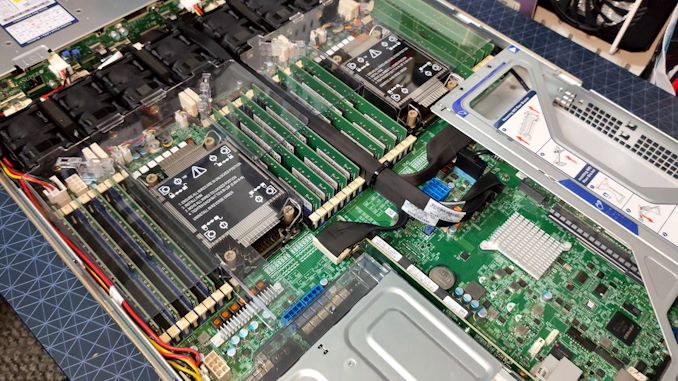
With the launch of Intel’s Ice Lake Xeon Scalable platform comes a new socket and a range of features that vendors like Supermicro have to design for. The server and enterprise market is so vast that every design can come in a range of configurations and settings, however one of the key elements is managing compute density with memory and accelerator support. The SYS-120U-TNR we are testing today is a dense system with lots of trimmings all within a 1U, to which Supermicro is aiming at virtualization workloads, HPC, Cloud, Software Defined Storage, and 5G. This system can be equipped with upwards of 80 cores, 12 TB of DRAM, and four PCIe 4.0 accelerators, defining a high-end solution from Supermicro.
Servers: General Purpose or Hyper Focused?
Due to the way the server and enterprise market is both expansive and optimized, vendors like Supermicro have to decide how to partition their server and enterprise offerings. Smaller vendors might choose to target one particular customer, or go for a general purpose design, whereas the larger vendors can have a wide portfolio of systems for different verticals. Supermicro falls into this latter category, designing targeted systems with large customers, but also enabling ‘standard’ systems that can do a bit of everything but still offer good total cost of ownership (TCO) over the lifetime of the system.
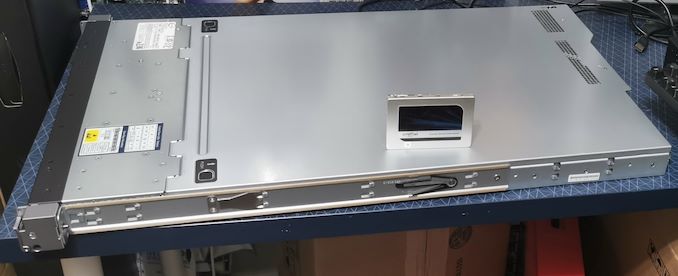
Server size compared to a standard 2.5-inch SATA SSD
When considering a ‘standard’ enterprise system, in the past we have typically observed a dual socket design in a 2U (3.5-inch, 8.9cm height) chassis, which allows for a sufficient cooling design along with a number of add-in accelerators such as GPUs or enhanced networking, or space on the front panel for storage or additional cooling. The system we’re testing today, the SYS-120U-TNR, certainly fields this ‘standard’ definition, although Supermicro does the additional step of optimizing for density by cramming everything into a 1U chassis.
With only 1.75-inches (4.4cm) vertical clearance on offer, cooling becomes a priority, which means substantial enough heatsinks and fast moving airflow backed by 8 powerful 56mm fans, which are running at up to 30k RPM with PWM control. The SYS-120U-TNR we’re testing has support for 2 Ice Lake Xeon processors at up to 40 cores and 270 W each, as well as additional add-in accelerators (one dual slot full height + two single slot full height), and comes equipped with dual 1200W Titanium or dual 800W Titanium power supplies, indicating that it is suited up should a customer want to fill it with plenty of hardware. You can see in the image above and on the right of the image below, Supermicro uses plastic baffles to ensure that airflow through the heatsink and memory is as laminar as possible.
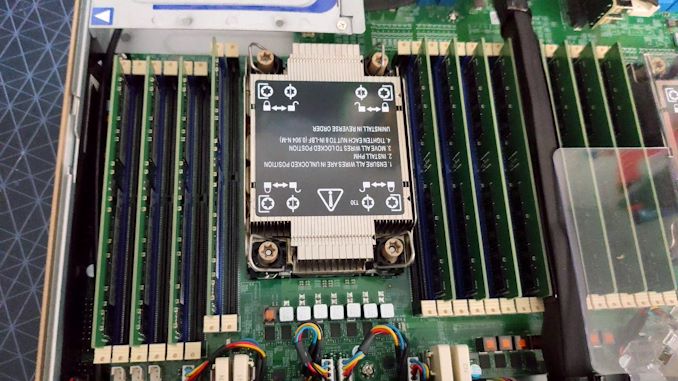
LGA-4189 Socket with 1U Heatsink and 16 DDR4 slots
Even with the 1U form factor, Supermicro has enabled full memory support for Ice Lake Xeon, allowing both processors sixteen DDR4-3200 memory slots, capable of supporting a total of 12 TB of memory with Intel’s Optane DCPMM 200-series.
At the front are 12 2.5-inch SATA/NVMe PCIe 4.0 x4 hot swappable drive bays, with six apiece coming from each processor. If we start looking into where all the PCIe lanes from each processor go, it gets a bit confusing very quickly:
By default the system comes without network connectivity, only with a BMC connection for admin control. Network options requires an Ultra add-in riser card for dual 10GBase-T (X710-AT2), or dual 10GBase-T plus dual 10GbE SFP+ (X710-TM4). With the PCIe connectors, any other networking option might be configured, but Supermicro also lists the complete no-NIC option for air-gapped systems. The system also has three USB 3.0 ports (2 rear, 1 front), a rear VGA output, a rear COM port, and two SuperDOM ports internally.
Admin control comes from the Aspeed AST2600 which supports IPMI v2.0, Redfish API, Intel Node Manager, Supermicro’s Update Manager, and Supermicro’s SuperDoctor 5 monitoring interface.
The configuration Supermicro sent to us for review contains the following:
- Supermicro SYS-120U-TNR
- Dual Intel Xeon Gold 6330 CPUs (2x28-core, 2.5-3.1 GHz, 2x205W, 2x$1894)
- 512 GB of DDR4-3200 ECC RDIMMs (16 x 32 GB)
- Dual Kioxia CD6-R 1.92TB PCIe 4.0x4 NVMe U.2
- Dual 10GBase-T via X710-AT2
Full support for the system includes:
| Supermicro SYS-120U-TNR | ||
| AnandTech | Info | |
| Motherboard | Super X12DPU-6 | |
| CPUs | Dual Socket P+ (LGA-4189) Support 3rd Gen Ice Lake Xeon Up to 270W TDP, 40C/80T 7+1 Phase Design Per Socket |
|
| DRAM | 32 DDR4-3200 ECC Slots Support RDIMM, LRDIMM |
|
| Up to 8 TB 32 x 256 GB LRDIMM |
Up to 12 TB 16 x 512 GB Optane 16 x 256 GB LRDIMM |
|
| Storage | 12 x SATA Front Panel Optional PCIe 4.0 x4 NVMe Cabling |
|
| PCIe | PCIe 4.0 x16 Low Profile PCIe 4.0 x16 Low Profile (Internal) 2 x PCIe 4.0 x16 Full Height (10.5-inch length) Ultra Riser for Networking |
|
| Networking | None by default Optional X710-AT2 dual 10GBase-T Optional X710-TM4 dual 10GBase-T + SFP+ |
|
| IO | RJ45 BMC via ASpeed AST2600 3 USB 3.0 Ports (2 rear, 1 front) VGA BMC 1 x COM 2 x SuperDOM |
|
| Fans | 8 x 40mm double thick 30k RPM with control 2 Shrouds, 1 per CPU socket+DRAM |
|
| Power | 1200W Titanium Redundant, Max 100A | |
| Chassis | CSE-119UH3TS-R1K22P-T | |
| Management Software |
IPMI 2.0 via ASpeed AST2600 Supermicro OOB License included Redfish API Intel Node Manager KVM with Dedicated LAN SUM NMI Watch Dog SuperDoctor 5 ACPI Power Management |
|
| Optional | 2x M.2 RAID Carrier Broadcom Cache Vaults Intel VROC Raid Key RAID Cards + Cabling Hardware-based TPM Ultra Riser Cards |
|
| Note | Sold as assembled system to resellers (2 CPU, 4xDDR, 1xStorage, 1xNIC) |
|
We reached out to Supermicro for some insight into how this system might be configured for the different verticals.
| Supermicro Ultra-E SYS-120U-TNR Configuration Variants |
||||
| AnandTech | CPU | Memory | Storage | Add-In |
| Virtualization | ++ | ++ | ||
| HPC | ++ | + | ||
| Cloud Computing | handles all mainstream configs | |||
| High-End Enterprise | ++ | ++ | ++ | ++ |
| Software Defined Storage | + or 2U | |||
| Application aaS | + | + | + | + |
| 5G/Telco | Ultra-E Short-Depth Version | |||
Read on for our benchmark results.


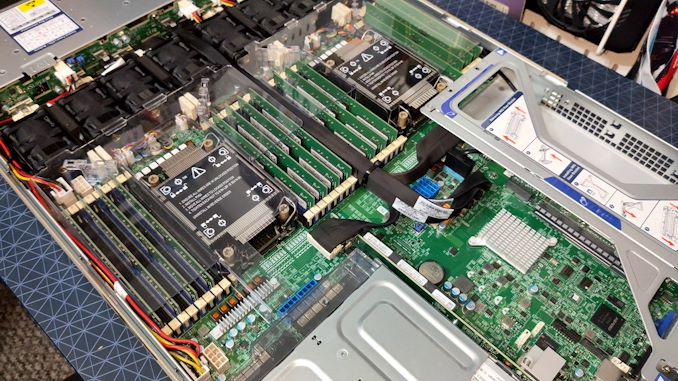

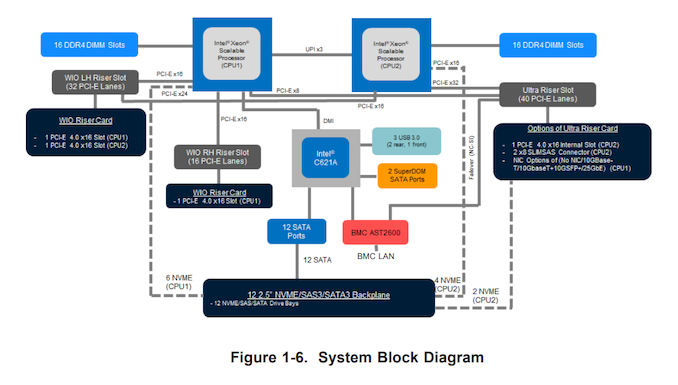










53 Comments
View All Comments
SSNSeawolf - Monday, July 26, 2021 - link
I'm curious why you say AMX is like AVX-8192. My understanding is that AMX is essentially a configurable fused multiply-add accelerator, with the added bonus of some configuration registers. However, I'm not an AI guy so I welcome corrections.mode_13h - Monday, July 26, 2021 - link
> I'm curious why you say AMX is like AVX-8192.Because that's how big the registers are. 1 kB each (there are 8 of them, BTW). As for the configurable part, it's true that operations don't have to use the entire register.
I'm not saying it *is* AVX-8192. Just that you could sort of look at it that way. The point was only to tie it into the lineage of what came before. For anything beyond that, you'll want to dig into the specifics and understand it for what it *is*.
mode_13h - Sunday, July 25, 2021 - link
If there's one thing Intel knows how to do, it's more of what they've done before!Foeketijn - Thursday, July 22, 2021 - link
Power and cooling is not cheap in a colo. Using 300W more for the same performance will set you back 1000 bucks a year easily.mode_13h - Thursday, July 22, 2021 - link
Yeah, I'd have expected power-efficiency to be the top priority, followed by density.Spunjji - Monday, July 26, 2021 - link
Ouch!mode_13h - Thursday, July 22, 2021 - link
Ian, the AVX 3DPM benchmark is concerning me. Given the grossly asymmetric optimization for AVX-512 vs. AVX2, I think it's not a good performance characterization for AVX2 vs. AVX-512 CPUs.If the AVX2 path could be optimized to a similar degree, then I think it would make sense to use it in that way. Unless/until that happens, I think you should only use it to compare like-for-like CPUs (i.e. AVX2 vs AVX2; AVX-512 vs AVX-512).
On a related note, please post the source somewhere like github, so that we actually see what it's measuring and potentially have a go at optimizing the AVX2 path, ourselves.
29a - Thursday, July 22, 2021 - link
I've also been complaining about ego mark forever and now they added that terrible AI benchmark to the lineup which they readily admit is bad data.mode_13h - Thursday, July 22, 2021 - link
He should just put it up on github and see what people can do with it. Plus, somebody might optimize it for ARM, too. He's already shared it with Intel and AMD, so what's the big deal?Dolda2000 - Thursday, July 22, 2021 - link
I don't think there's anything particularly wrong with that. It may be disproportionate to other benchmarks, but if all benchmarks scaled the same, there'd be no point in having more than one at all. It's a real-world workload (custom in-house programs are perhaps the most real-world workloads there are), and it does demonstrate the fact that some programs really benefit by AVX-512.Realistically, I don't think it should've been shared with Intel and AMD (it would've arguably been better if it were "pristine"), but given that that has been done, I'd agree there's no point to not making it public any longer. That being said, I'm not sure the point should be to microoptimize it to the ends of the world, or it wouldn't be a realistic workload any longer.